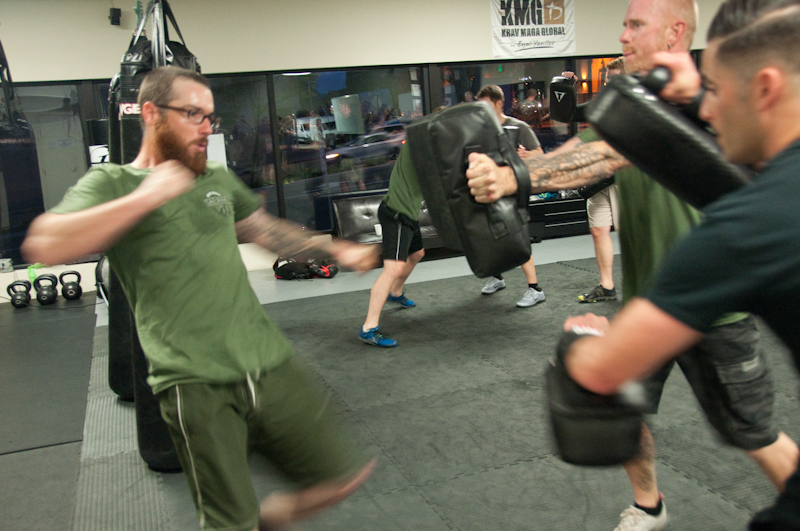

Dealing with Multiple Attackers – Krav Maga Style
Krav Maga is a multifaceted system of self-defense and fighting. One, relative unique feature of Krav Maga is that it trains fighters how to handle multiple assailants, both armed and unarmed. Training to defend against multiple attackers starts very early in the student’s development. Very often we go through drills where students have to operate in large crowds, or defend and/or avoid a series of attacks from multiple partners, find and engage secondary targets, and more. As students progress a bit further with their training and access our full contact classes, they get introduced to sparring drills against multiple partners. And ultimately in our advanced classes we spend time defending against multiple assailants armed with various weapons, such as knives and clubs.
To help you improve this aspect of your training we wanted to touch upon the essential elements behind the concept of fighting multiple attackers. There are four elements to this skill that are interconnected and are dependent on each other.
The first key element is spatial awareness. This is the ability to position yourself in such a way that you are never directly surrounded by your aggressors. The goal is to always line up the attackers so that at least temporarily you are facing one attacker at a time. Spatial awareness can and should be practiced even when working with a single partner. Every time you end a technique, move away from the partner while maintaining fighting stance, and scan your surroundings to get accustomed to looking for other dangers and orienting yourself appropriately within your training environment. Hence this is why you always hear us say “don’t forget to disengage and scan”.
Of course, being able to line up your attackers requires good footwork, which is the second key element behind multiple attacker fighting. You often hear boxers talk about how the key to boxing is not your hands, but your feet; the ability to outmaneuver your opponent while maintaining balance, speed and agility. With multiple attackers you now have to outmaneuver more than one opponent, which means that basic footwork and mobility in fighting stance are essential to your success. We practice basic movement routinely in class, so with each day you should see some improvement in this aspect of fighting.
With good movement, you create openings to deliver strong and decisive strikes to your attackers. This brings us to the next key aspect of multiple attacker fighting; not being a defensive fighter. Remember, the principle of Krav Maga is not just to defend, but as soon as possible to deliver good counterstrikes in order to neutralize your opponent and escape with minimal harm to yourself and loved ones. This becomes even more important when facing multiple attackers. Think of it this way, if you are fighting two attackers, they have a total of four arms and four legs that can be used to attack you, while you have half as many limbs to use for defense. So focusing on defense alone is setting you up for failure. Instead, take the fight to them. Move to line them up, and create openings for a good combination to stop or slow your opponents down. This aspect of multiple attacker fighting ties in with the previous two. You need to be aware of the attackers’ positions, be able to move so that you line them up and have the ability to strike well at different ranges to inflict damage to your assailants. Therefore we routinely train striking in all of our classes to ensure that you have the necessary tools to deal with these scenarios.
The last key concept is understanding distance and range in relations to your attackers. This means that you need to understand at which distance you can successfully engage your opponents. Similarly you need to understand at which range you become vulnerable to their attacks. And lastly, if the attackers are armed, you need to understand which attacker is more dangerous at what range depending on the type of weapon they have and their position in relations to you (examples: short range and long range weapons such as knives and sticks). We learn to negotiate and work with ranges daily in class. Whether it’s working with a partner in our regular Krav Maga classes on defending punches, kicks, grabs, weapons, etc., or striking with different set of combatives in our striking classes, or sparring in our full contact classes, we intuitively start understanding ranges and how they can be used in our advantage or against us. Of course ranges and distances are highly variable and are dependent on your movement, and the movement of your attackers. Hence the aspect of distance and range strongly ties into the previous three components: spatial awareness to identify the position of your attackers, movement to always position yourself at the best range to allow successful strikes to neutralize your opponents, while avoiding the majority of their attacks. In fact the best rule of thumb when it comes to multiple attacker training, is that your movement in relations to your attackers should always have a clear purpose. Whether it’s to avoid their attacks or set up your own, you are always one step ahead of them. Take the fight to them!
Good luck in your training.
